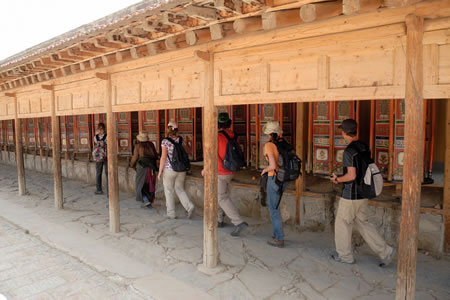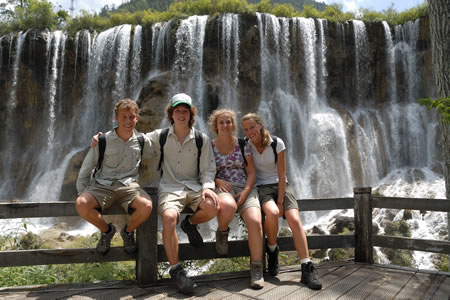English | Dutch |
|
| On the road with the six of us | |
Sainshand (Mongolia) to Chengdu (China), July 2010 |
|
After our visit to the eastern part of Mongolia, we cross the Trans Mongolian railroad with our Russian van and enter the Gobi desert. We didn’t have any real expectations of the Gobi desert. All we knew is that the Gobi isn’t a ‘traditional’ desert as most people would expect. But what is it? It doesn’t take long before we notice that the Gobi is an extremely diverse area. Of course, you will find some sand dunes, but they only cover three percent of the whole Gobi desert. You will also find beautiful mountainous areas, but most of the desert is covered with grasslands, where nomad families feed their animals. However, don’t expect the typical bright green grass fields as you probably have them at home. We drive for days and days over the desert plains where we once in a while encounter a group of camels. Sporadically, we also cross a small village where we refill our provisions and where we eat some ‘buzz’ (traditional yak dumplings) at the local food outlet. The villages are without any exception dusty and unappealing. This has to do with the fact that all houses are surrounded by wooden fences that protect the houses from the icy wind in the wintertime. In the summer, they keep the dust as much as possible out. Our main destinations in the Gobi are the sand dunes and the ‘flaming cliffs’, beautifully red coloured cliffs that are world famous because of the fact that many dinosaurs bones and eggs are found in this area. It was a pity that we couldn’t see any ongoing excavation activities in the area. The only dinosaur bones and eggs we saw were the ones in a little museum. A big difference between travelling in the eastern part of Mongolia and here is that the contact with the ‘real’ nomads disappeared. Our driver and guide are on known territory, which means that they don’t have to ask for directions anymore. And asking directions at nomad families is a great way to get in touch with them. But also in the Gobi desert we spend the night in a nomad camp once in a while, but these nomad families are used to tourists. Most families in the area use one of their spare gers (nomad tents) to rent out to travellers. So, unfortunately, these are not the nomads anymore that welcome you with the typical nomad hospitality, and for whom you are still a real novelty. |
|
 |
|
Walking the 'kora' (pilgrimage) in Xiàhé |
|
| After our journey through Mongolia we take the train back to the Chinese capital Bĕijīng. Gradually, the day arrives that we are on the road with the six of us. Two children of friends of ours (Fay (19) and Sten (17)), decided to come to China and travel with us for a while. Because both of them also bring a friend (Anne (17) and Joris (18)), our group is temporarily increased from two to six people. On July 17th, we meet them at the Bĕijīng Capital International Airport. We stay for one more day in Bĕijīng to visit the Forbidden City after which we leave crowded Bĕijīng to visit the less densely populated areas in the west. We had the plan to travel to Lánzhōu by an overnight train, but because of the busyness of the tourist season, we have to take the bus. The advantage of this route through the provinces of Inner Mongolia and Ningxia is that we also visit the cities of Hohhot and Yínchuān, where foreign visitors are still a novelty. In a supermarket an amazed little girl puts both hands before here open mouth when Edwin with his length of two metres passes her. After Lánzhōu we travel south to the small town of Xiàhé. This town is especially popular with Tibetan pilgrims that come here to visit the holy Labrang monastery.
When we try the buy the tickets for Xiàhé in Lánzhōu, the lady who sells the bus tickets wants to have a copy of our passports. Xiàhé is still a potential hotspot for the Chinese authorities, so they want to know exactly who is going to travel to this area. The Tibetan community of Xiàhé is very solidair with their brothers and sisters on the Tibetan plateau, and that means that when there are riots in Tibet, like in March 2008, there are also riots in Xiàhé. For the 2008 riots, this meant that Xiàhé was afterwards virtually sealed off from the outside world for several months. After our first acquaintance with the very friendly Tibetan people we try to travel via Xīníng to the Tibetan plateau. Our first destination in the town of Yùshù in the province Qīnghăi, but when we try to buy bus tickets in Xīníng, we are not allowed to travel to this area. This town is too close to the border with Tibet and the message they give at the bus station is very clear: ‘you are not allowed to go there’. And that is strange, because we visited the town a little bit more than two months ago without problems. | |
 |
|
Our travel mates pose at a waterfall in Jìuzhaigou National Park |
|
Eventually, we travel back to Lánzhōu and take from there the bus to the village of Lángmùsì. The village is also known for its beautiful monastery, but we also make a great walk in the surrounding hills. During this hike we are invited for an unforgettable visit to a nomad tent. The lady doesn’t speak any English or Mandarin, and because she can’t read, also our Tibetan phrase book is unusable. But her brilliant smile tells more than thousand words. She is very happy and proud to have the six of us in her small nomad tent. After Lángmùsì we travel to the famous Jìuzhaigou National Park in the northern part of the Sìchuān province. The beautiful landscape of this park, consisting of rugged mountains, extremely picturesque waterfalls and colourful lakes is almost unbeatable, but the huge numbers of tourist makes it sometimes difficult to enjoy the sights. The park is also extremely pricy; more than 30 Euros per person for just a single day admittance. We always wonder in these situations how the normal Chinese people can afford this. Chengdu is our next destination where we want to see the Panda’s of the Chengdu rehabilitation centre. It is great to see these special animals, but it is a pity that the centre is a veiled zoo. They even give the visitors the possibility to pose with a baby panda in their arms. Of course, for an additional fee! We can’t imagine that this is the objective of a rehabilitation centre whose goal it is to set out the animals to the wild again. But also here, money is more important than the wellbeing of the animals. Money talks, especially in China. The journey with Fay, Anne, Sten and Joris is almost halfway now and it is great to see how much they enjoy themselves. We travel on exactly the same way as we do with the two of us. And that means that we don’t spare them at all. It is great to see how fast they adapt themselves to the situation. Extremely dirty toilets, long bus rides with huge delays, ill-mannered Chinese people and walking with a backpack through hot and steamy Chengdu; we never heard them complain. They already know that also this is the charm of travelling.
|
|
| <Previous weblog> | |